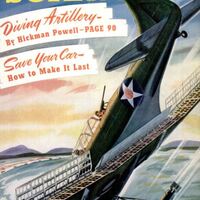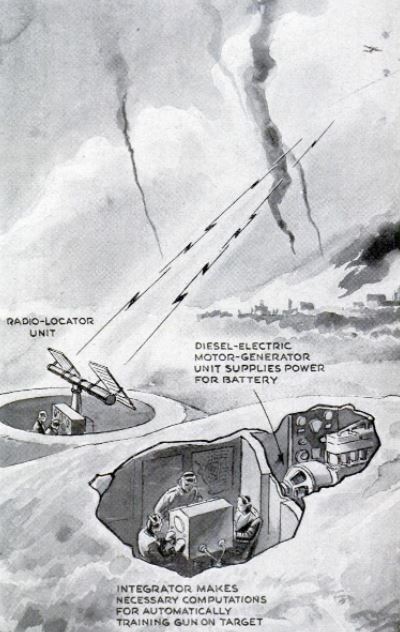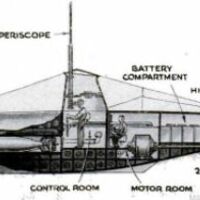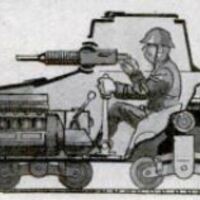New Axis Weapons
Item
-
Title (Dublin Core)
-
New Axis Weapons
-
Article Title and/or Image Caption (Dublin Core)
-
New Axis Weapons
-
extracted text (Extract Text)
-
WHEN the U.S. Navy captured its
first enemy warship, during the
Pearl Harbor attack, it verified one
of a number of persistent reports of new
Axis war weapons. The beached craft
proved to be a midget Japanese two-man
submarine, intended for suicide attacks at
short range. Examination showed that the
type measures 41 feet long, with a stubby
conning tower and periscope. It carries two
undersized torpedoes, plus a 300-pound ex-
plosive charge to blow up the submarine
itself and anything near it. Driven by elec-
tric motors alone—standard craft use Die-
sels on the surface to save and recharge
the batteries—the midgets have a low-speed
cruising radius of no more than 200 miles.
But they are small enough to be carried on
the decks of a surface
ship, and lowered into
the water near their
objective. Their first
trial, at least, was a
failure; one went
aground and another
was detected and sunk
when the pair at-
tempted to slip into
the harbor.
A one-man tank,
another “pocket” Jap-
anese weapon, has
taken part in fighting on the Malay Penin-
sula. In these lightweight machines, the
driver serves as his own gunner. Vulner-
able to antitank fire, they nevertheless are
well suited to landing operations, and may
constitute a serious threat by sheer weight
of numbers. Likewise, a two-man Japanese
gun carrier sacrifices armored protection
for ability to negotiate jungle terrain.
From the European theater of war come
reports of other military novelties. As Ger-
many begins to pass from the offensive to
the defensive in the air, it appears to have
developed a new type of installation for
antiaircraft defense. Radio lo-
cators developed in Germany
and other countries have al-
ready made it possible to de-
tect invisible air raiders, and,
through an electrical brain
called an integrator, to trans-
mit firing data to the gun
crew. A current refinement is
said to make the guns respond
automatically to the firing da-
ta, training themselves, set-
ting shell fuses, and firing of
their own accord as long as
the radio locator is “on tar-
get.” One of the few sources
of human error is thus elimi-
nated, and the duty of a re-
duced gun crew becomes sim-
Ply to keep the magazine filled
with ammunition.
On the offensive side, incen-
diary bombs with delayed ex-
plosive charges have been
ascribed to German techni-
cians. Outwardly resembling
standard fire bombs, which
Britishers have learned to
handle and remove from build-
ings, the combination type
burns for a short time and
then explodes. Complicated to
manufacture, it probably
would not be used on a large
scale; but a few of these bombs mixed with
those of standard type would be calculated
to make persons keep away from all incen-
diary missiles, while they served their pur-
pose of starting fires.
A “human torpedo,” reportedly tried un-
successfully by the Italians at Gibraltar,
may be a development from the previous
World War. At that time, two Italian offi-
cers straddling a compressed-air “torpedo”
managed to penetrate the defense of Pola
Harbor and detach warheads that sank two
major Austrian naval vessels. An American
inventor, Otto Frindt of Chicago, has modi-
fied the idea in a gasoline-powered, human-
piloted torpedo that automatically tosses
its rider into the water before striking its
target.
And whatever other war innovations the
Axis may have for us, it is a pretty safe
bet that Uncle Sam has some surprises up
his own sleeve, ready for use when his land,
sea, and air forces come to grips with the
enemy in any part of the world.
-
Contributor (Dublin Core)
-
B.G. Seielstad (Illustrator)
-
Language (Dublin Core)
-
eng
-
Date Issued (Dublin Core)
-
1942-04
-
pages (Bibliographic Ontology)
-
98-101
-
Rights (Dublin Core)
-
Public Domain (Google DIgitized)
-
Archived by (Dublin Core)
-
Roberto Meneghetti
-
Marco Bortolami (editor)
 Popular Science Monthly, v. 140, n. 4, 1942
Popular Science Monthly, v. 140, n. 4, 1942








